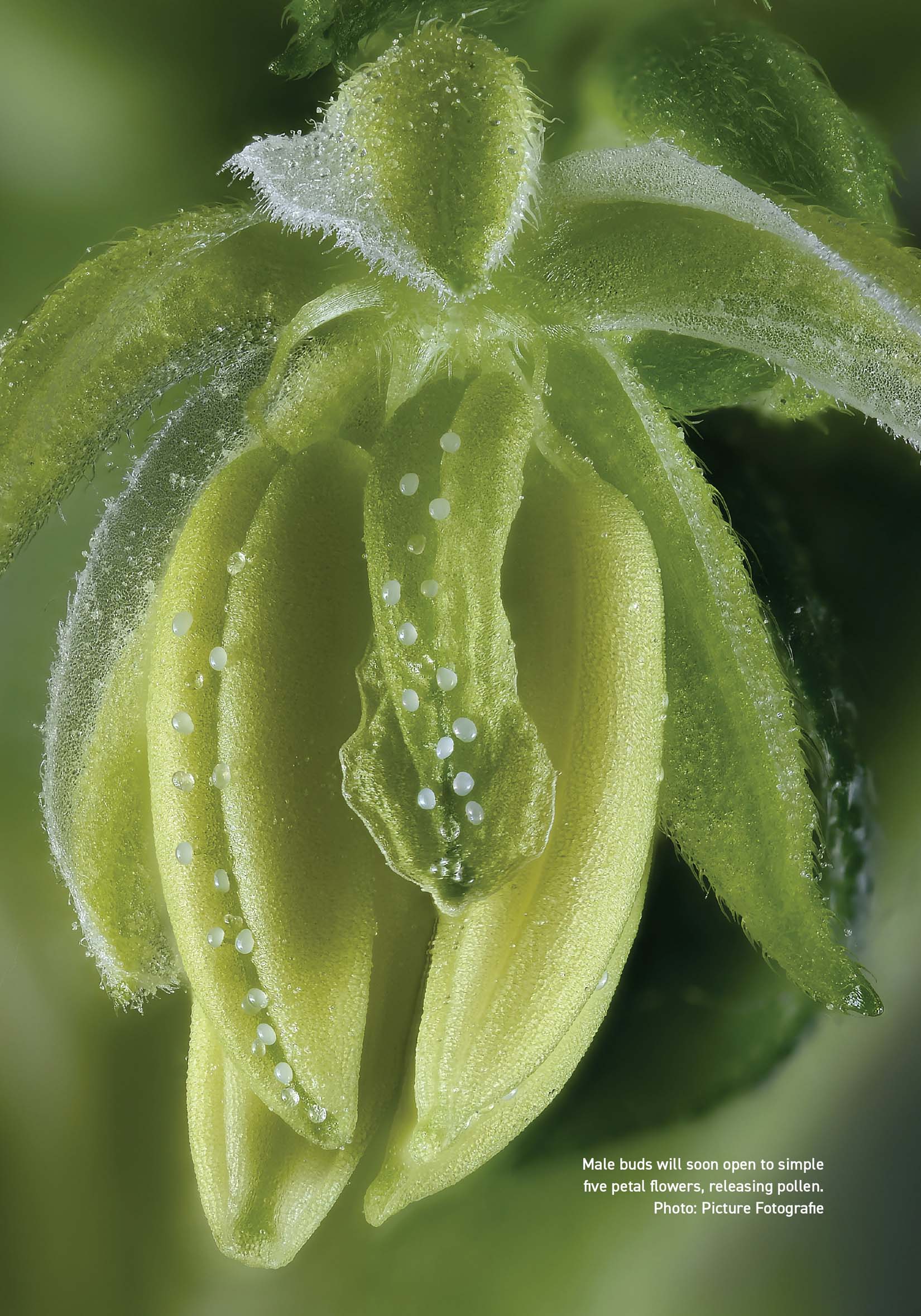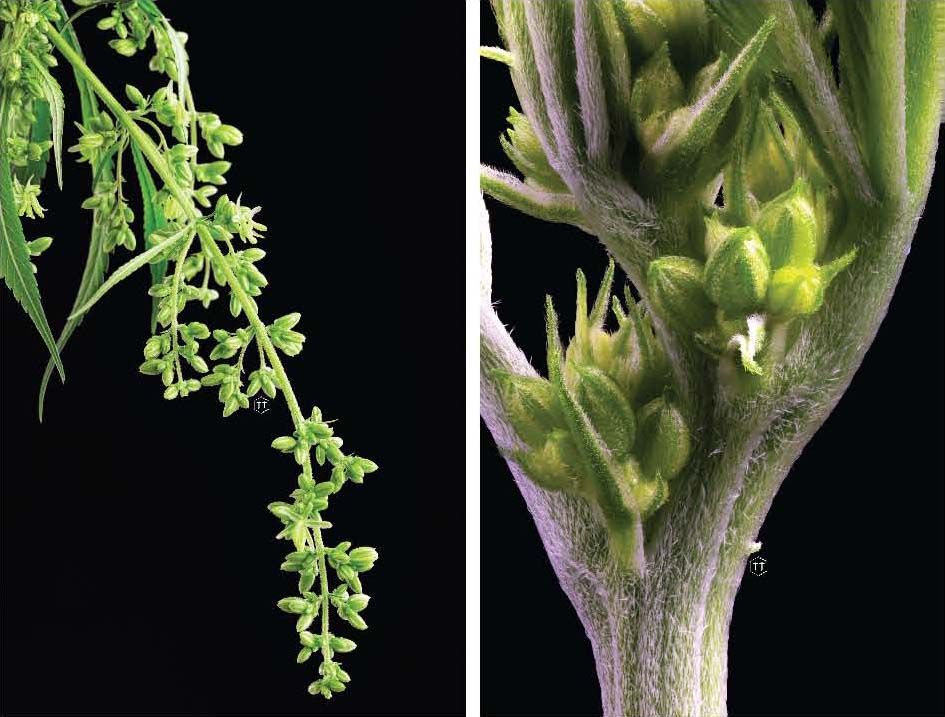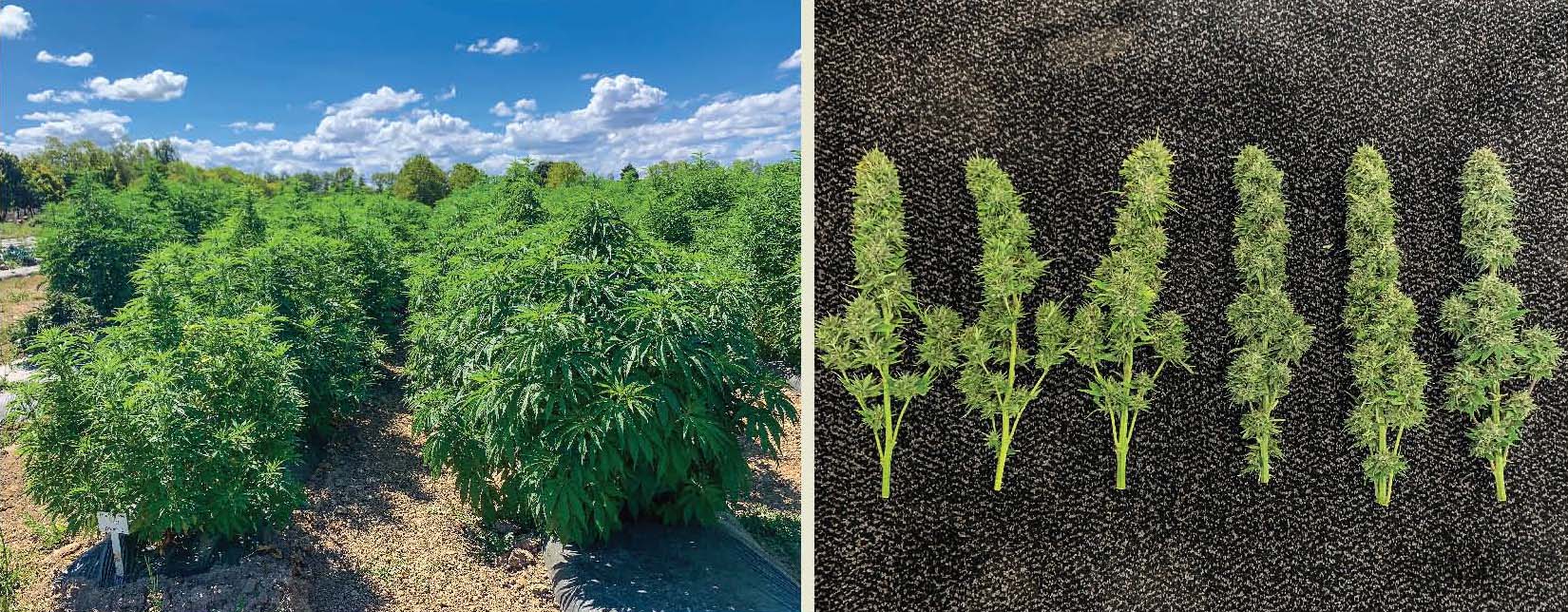
BASIC BREEDING
The progenitor of cannabis and hops originated in the Himalayan foothills at a time when there were seasonal differences but the weather was warm enough throughout the year to sustain active vegetative growth. This plant was probably a short-lived perennial that lived and flowered annually but survived for several years. Because it had no need for it, this plant never developed a way to deal with freezing weather.
The plant adapted as the climate changed to be more temperate with more varied seasons. It had to deal with an annual cold period that included freezing temperatures. The progenitor plant developed two paths to cope with the new circumstances.
Hops remains a perennial plant. The above-earth canopy dies back each autumn but has a woody root system that can stretch deep into the soil, storing energy produced by the previous season’s photosynthesis. In the spring it grows feeder shoots to harvest nutrients found in the shallower soil sections and regrow the canopy. Hops is propagated by seed and rhizomes that stretch from the plants and lay down roots in suitable areas.
Cannabis became an annual plant that germinates, grows, flowers, produces seed, and dies in a single season. Cannabis can also regenerate after flowering in warm climates, where the weather encourages plant growth throughout the year.
Researchers think that the early symbiotic relationship between plants and humans helped cannabis travel the world. One of its unique qualities is that unlike most cultivated plants it can become feral and invasive. The alternation of cultivation and feral growth and contact between these populations played a crucial part in the development of modern cultivars.
Plants growing in temperate areas experience a varied environment. One year it’s rainy, the next year sunny, cool, or cloudy. Temperate cannabis adapted to these vagaries and maintained a heterogeneous gene pool. When a population has a wide array of alleles, a percentage of the plants will do well or less poorly than others no matter the weather.
Random vs. Intentional Breeding

Left: A male branch with flowering pollen sacs. Right: close-up of male flowers at the node. Photo: Phil Sullivan / Team Terpene
Random breeding is when the seed collector who mixes all the acquisitions grows them out and allows for uncontrolled pollination. The theory is that the seeds are from good cultivars, so it’s possible that they will result in some outstanding crosses to select from.
Although this technique is exciting, the “hang it up and see what tomorrow brings” method of breeding has fallen out of style because there is no provenance, no crosses that can be verified. This makes it difficult to register the hybrid as intellectual property.
The other classical technique is to study the various characteristics of plants and then to choose which to cross based on characteristics such as resistance to disease or predation, ripening time, growth pattern, and profile of cannabinoids and terpenes.
Modern commercial breeding uses genetic profiling to help make selections. DNA is found in the chromosomes, which are always found in pairs in nature. For instance, by analyzing certain snippets of DNA, it can be determined if a plant is autoflowering or if it will produce THC or CBD. Some of the analysis can be quite specific. Anyone who has used a genetic service such as 23andMe or Ancestry.com is aware of just how “personal” it can be, and the same goes for each plant and its DNA.
Some of these techniques are already being used commercially and by hobbyists.
Cannabis is the most widely bred plant in the world. Between hobbyists, breeders, and all the small and large seed companies, it is an enormous research pool that no other crop enjoys. One reason for the proliferation of cannabis breeding is that it’s far easier to breed than most other crops.
Unlike almost all other annual plants, cannabis is dioecious, that is, it has separate male and female plants. This is another clue that it began as a perennial, because a small percentage of perennial plant species are dioecious.
Monoecious plants have either separate male and female flowers or “perfect” flowers—defined as having both male and female reproductive organs. To breed a perfect flower one has to use a tweezer to pull out the male organ, the pistil, before it matures, gather the pollen from the pistil of a different plant and paint it on the stigma. This is a painstaking task.
Cannabis is easy to propagate because it is dioecious. There are several techniques, but the most commonly used are the following:
- Male and female plants are separated. All males are destroyed except for the ones to be used for breeding. The pollen is gathered from the selected male(s). This is easily done by laying the male plant down horizontally and placing tarps under and over the plant. It will shed pollen that can be collected. Then the pollen is painted onto female flowers with a watercolor brush.
- Males and females are separated. All males except for breeding candidates are destroyed. All females to be pollinated and the selected male are placed in a pollen-tight space. A fan keeps the pollen circulating in the air until it’s captured by the stigmas and used to produce seed.
Chromosomes are composed of genes and are the blueprint for everything about the plant. A gene can have any one of many versions, but they are found in pairs, one in each chromosome. Some alleles (versions of the gene) are dominant, some are partially dominant, and some are recessive.
A dominant allele imposes its traits without regard to the other allele. An example of this is the known model for THC potency in cannabis (Campbell et al. 2020). THC potency is not just phenotypically represented by a single allele; it is a complex group of alleles that all show signs of dominance. This is likely why early cannabis breeders were able to relatively easily focus on THC concentrations in the offspring of bred varieties. The alleles were dominant and were more likely to be expressed.
A partially dominant allele pairs with the other allele to combine the trait. For instance, a tall and a short plant may produce one between the parents’ two heights.
A recessive allele gets sublimated by a dominant allele. When crossed with a non autoflowering plant the resulting plant will be autoflowering.
There are many methods and terms used in breeding.
- F1 is the first generation from a cross. If the lines are stable this generation will be uniform because all the plants are receiving similar alleles. One half of the pair comes from each parent.
- F2 is a cross between two F1s. These plants receive one allele from each parent, but the parents have mixed pairs of alleles, so they sort out into many combinations.
- Backcross refers to a plant that has a desirable characteristic (A) that one wants to transfer to another plant (B). First the two plants are crossed, and then a product of the cross (C, which is 50% B) is crossed back to B. In the next generation (D, which is 75% B), only some of the plants will have the desirable characteristic. One of the Ds with the characteristic is crossed back to B to produce E, which is 87.5% B. This may continue for several more generations to generate a plant with similar genetics of B with an A characteristic or B with the desired characteristic from A.
What Is Seed Stability?
Stability in cannabis breeding refers to how uniform the offspring are.
If a male and female plant are bred together, this means that their genetics are being crossed through sexual reproduction. The offspring are genetic mixtures of the parents. If the offspring exhibit different traits (such as varying heights), they are said to be unstable. However, if the seeds produce plants that show uniform traits, they are said to be stable.
Breeding for uniformity and stability is important for growers who grow from seed as opposed to clones. Growing from stable sources of genetics allows for a greater uniformity in the final product, which is a goal for commercial growers. Hobbyists may find genetic stability less valuable, as they are more open to seeing what the randomness of sexual reproduction brings them.
Essentially, stable cannabis varieties have more homozygous dominant traits than an unstable variety, which would have more heterozygous alleles. Stable parents typically produce predictable offspring, which is desirable for large-scale growers who cultivate from seeds. To achieve this desired goal, breeders will cross varieties with themselves (called “selfing”) or crossing with their siblings. Backcrossing is when the offspring is bred with a previous generation (mom/dad, grandma/grandpa, etc.). Inbreeding the genetics with siblings or previous generations will, over many generations, result in offspring that have more uniform, homozygous, predictable, and hopefully desirable phenotypes.
Feminizing Seed
Feminized seeds produce female plants. When they germinate, there will be few males among them if they are produced correctly. The threat of accidentally pollinating crops by misidentifying a male as a female is minimized.
The only ways to preserve the exact genetics of a plant are by cloning or regeneration. (See Appendix D: Regeneration.) One reason to use this technique is because a plant crossed with itself produces seeds that retain its parents’ favorable characteristics. Another reason to use this technique is to create a hybrid of two female plants.
A female plant can be manipulated to produce male flowers, and thus pollen to pollinate female flowers even with no male plants around. Feminized seeds are produced by inducing a normal female, not a hermaphrodite, to grow male flowers with viable pollen.
Cannabis is similar to humans in that each plant has a specific gender, male or female, that is designated genetically by an X or a Y chromosome. Pollen produced from male flowers borne on a female plant will have only the X chromosome. The progeny will inherit an X from the male flower’s pollen and an X from the egg. The resulting seeds can only inherit two X chromosomes, which means that virtually all the resulting seeds will be female.
Getting only female plants was the motivation for creating feminized seeds, but they offer other advantages. Feminized varieties are more uniform (homogeneous) than “regular” seeds. Plants from feminized seeds tend to look more like each other and produce a more uniform harvest.
Even when using feminized seeds, there is still a small chance that a few plants will be hermaphrodites (truly both male and female) or males. If feasible, plants should be monitored through the entire growth stage to check for these oddities. Maintaining stable growing conditions is the best way to prevent male or hermaphroditic plants. Environmental stresses such as light, disruption, or over pruning will encourage female plants to produce pollen. If a male or hermaphrodite is found, remove it.
Feminized seeds are not as mysterious or weird as they might seem. In mature human females, taking male hormones causes masculinizing changes such as breast shrinkage, muscle bulking, and a lowering in voice pitch. The primary sex organs have already been formed, but they shrink.
A similar thing happens when female plants are treated with masculinizing chemicals. The difference is that while a mature human has already formed sex organs, every time a plant produces a new flower, it is growing a new sex organ. Plants under chemical influence grow viable male flowers: even though the plant is still a female with two X chromosomes, the pollen has only female chromosomes.
There are several methods used to produce feminized seed. By far, the easiest method was developed by the noted breeder Soma. He noticed that when colas of many varieties reached late ripeness, a few viable male flowers (often called bananas) developed. This is also a sign that the buds are ripe. Harvest the pollen using a fresh watercolor brush and brush it directly on the flowers or store it in a small glass or metal container. Not all varieties produce male flowers at the end of ripeness, but many do, and they do it reliably. Very small amounts of pollen are produced using this method, but a little pollen applied properly goes a long way.
Some varieties flower normally outdoors but experience indoor growing conditions as stressful and produce male and female flowers as a result. The pollen from the male flowers can be used for breeding, provided that the resulting plants are going to be grown outdoors, where they won’t exhibit the unwanted hermaphroditism. This method has inherent risks of hermaphroditism in the resulting plants.
Plant stresses such as irregular light cycles and heat sometimes induce hermaphroditism. However, stress techniques are not reliable. They only seem to work when unwanted; most environmental stress regimens are unreliable in invoking male flower production. Should this happen accidentally in a garden with a valuable variety, opportunistic growers often collect the pollen, even when there are no immediate plans to use it.
Laboratories and commercial seed producers use three chemicals to induce male flowers in female plants: gibberellic acid, silver nitrate, and silver thiosulfate. They each inhibit the plant’s production of ethylene, a hormone that promotes female flowering. Without ethylene, female flower production is reduced or stopped. The actions of these chemicals are localized. If only one branch of a plant is sprayed, that branch will be the only one affected.
The rest of the plant will continue growing female flowers, not males.
Gibberellins are hormones that plants produce to regulate many phases of their growth. Several of the gibberellins, such as GA3, 4, 5, and 7, induce male flowers when they are sprayed on female plants before they begin flowering. GA3 is the most effective and the gibberellin most commonly available commercially. For best results, use a solution of 0.01% (0.1 gram GA3 in a liter of distilled water).
Gibberellin must be used carefully. Lower doses result in fewer male flowers. Higher amounts have an inhibitory effect. Lightly spray the tops of the plant for five consecutive days and then force the plants to flower by increasing the uninterrupted dark period to 12 hours a day. The sprayed area will stretch a bit, but within two weeks, the first signs of male flowers will appear. They will be ripe and ready to release pollen in another two weeks.
Silver thiosulfate is more effective than silver nitrate, that is, it induces more male flowers. Sometimes the two chemicals are used together. It is usually recommended to spray the plant until the liquid drips off the leaves. Then immediately change the light regimen from vegetative to flowering. It is usually suggested that the leaves will droop and stop growing for a few days, yellow a bit and then regain turgidity. Male flower growth will become apparent in a couple of weeks. The flowers will ripen a few weeks later. However, drenching until drip-off has experimentally resulted in extremely stressed plants that produce few flowers. Lightly spraying the leaves as the light deprivation regimen is begun and then again once a week for two weeks results in stalks that produce flowers with fertile pollen.
Silver thiosulfate is made by combining two water solutions, one containing silver nitrate and the other, sodium thiosulfate. Silver nitrate alone can also be used to induce male flowers. Spray a solution of 0.02-0.03% on the plant, and then turn the lights to a 12-hour flowering cycle. The leaves will droop for a day or so and then resume turgidity. Male flower growth will become apparent in a couple of weeks and ripen a few weeks later. To make a 0.02% solution, add 0.1 gram of silver nitrate in half a liter of distilled water.
Because of market demand, almost all the seed companies offer most of their popular varieties as feminized seed. They are the best choice for most gardeners. The exception is gardeners interested in breeding.
